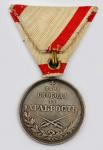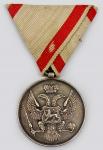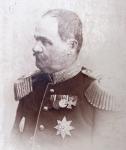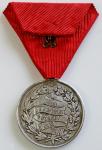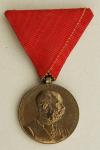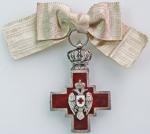
bovec1313
Past Contributor-
Posts
155 -
Joined
-
Last visited
Content Type
Profiles
Forums
Blogs
Gallery
Events
Store
Everything posted by bovec1313
-
Austria-Hungary Bronze ''Signum Laudis'' and his former owner
bovec1313 replied to bovec1313's topic in Austro-Hungarian Empire
-
Amazing the set of Iver has presented; to have medal & portrait of the bearer; and even picture of his grave. Congratulations. One of the first medals of bought as a young collector many years ago was a bronze Signum laudis in box. Medal was in nice condition, but placed in late simple cardborad box. It took very many years until I've noticed some wording on the reverse of the box; there the name of the recipinet and unit was writen, ''Lt. Ivanetic Franz, aus Krain 17''. With the help of Shematismus of KuK Heer I've found out that leutnant Ivanetic was primaril serving in IR17, but was temporary assigned to IR87, as company commander. For me it was great that both regiments were a Slovenian ones; But I was even more lucky to get the recomendation for his award in Military archives in Vienna, where his brave deeds are described. He was decorated in most glorious battle at Isonzo front, for famous ''miracle by Caporetto'' ofensive against Italians in October 1917. However his deeds did not bring him higher award, as his acchievemnt was that he'' with skillfull leading of his company in spite of heavy enemy's artilery and machine gun fire he had brought his company without looses'' attacked Italians at Cukli vrh on October 24. He was wounded in the action. He was recomended for bronze MVM with swords on 25. 11. 1917 by his regimental commander. What is interesting to follow on document is the path of needed confirmation for award. According to form itself, recomendation should be confirmed/approved by brigade, division, korps and army commander. Every of these approved decoation and put his stamp & signature on the form. It went very fast; Brigadier approved on 26.11, Divisionar on 28.11., Korps commander already on 30.11. and commander of the k.u.k. 2. Isonzo Armee finaly approved decoration on the 4.12. Unfortunately I'm mising the picture of leutant Ivanetic; but this is a chalenge to find it.... I'm enclosing picture of Signum laudis and recomandation for decoration
-
Austria-Hungary Signum Laudis for generals
bovec1313 replied to bovec1313's topic in Austro-Hungarian Empire
Thanks Josef; I've got the catalogue few days ago; I'm only wandering what price will it realise.... -
Hi Lilo, very interesting pictures indeed. (Silver) Medal for Bravery has indeed red-blue-white ribbon, but only untill 1895; later white ribbon with red stripes was used. However, Gold Medal for Bravery (official name is Medal for Bravery ''Milosh Obilich'') has all the time red-blue-white triangular ribbon. In your text it's explicitely stated ''Medal of courage in silver'', so it's no doubt its the silver one. In D'Annunzion was in no way decorated before 1895. Maybe there is an explanation Montenegro was defeated and conquered by KuK troops in January 1916; royal family went to exile in Italy, where decorateions were bestowed further on. It's possible that in exile Chacellery of Orders was probably in shortage of some decorations and ribbons and it was used what was on stock. So, it's not so unusual that Medal for Bravery was bestowed on wrong (or old) ribbon. That was not the time to look after all details... I'm enclosing pictures on Medal fro Bravery ''Milosh Obilich''
-
Dear Lilo, The First decoration is ''Order of the Danilo I for Independent of Montenegro''. As it's the ONLY Monenegrian order (with exception of the Order of St. Peter, but this one was bestowed only to the members of the royal house), it must this one. Instituted in 1853, finaly got 5 classes. D'Anunnzio (acording to your data) was awarded with Class III, a neck badge. Ribbon was white with red stripes at the edge. Obverse has a royal cypher D I in medalion, with circumscription ''Lord of Montenegro''. Reverse bears wording 'For Independance of Montenegro 1852 - 1853'' Medal is Silver Medal '' For Bravery '', instituted in 1941 and awarded until existing of Montenegro, 1918. Ribbon is the same, white with red stripes at the edge, so called Montenegrian ''war ribbon''. Reverse bears wording '' Faith / Freedon / for Bravery / I'm enclosing pictures of both decorations
-
Austria-Hungary Austrian Decorations of GdI in WW2
bovec1313 replied to Alexandre's topic in Austro-Hungarian Empire
According to ''Ranglisten des KuK Heeres 1917'' major (promored on 1. Nov. 1914) Emmerich von Nagy had following decorations: MVK with KD Silver MVM Bronze MVM Jubilëumskreuz 1908 Errinerungskreuz 1913 (Mobilization cross 1913) EKO III and swords were awarded later, as well EKII For the last three bars I can't see details; it indeed might be Jubiläumskreuz 1908, Karlkreuz and Mobilization Cross 1913. What is interesting, bar is missing all three commemorative medals awarded for WWI; German, Austrian and Hungarian, which were all three bestowed in huge numbers to participants of WWI of all three countries. A high ranking officer for sure must got them. -
Yankee pointed me this topic, even it's almost 4 years old, still I would like to make some comments; On my opinion the guy was at the end Bulgarian citizen; as first order and medal on the clasp are Bulgarian ones. I’m not surprised that Turkish of Medjidie is on the last place; I’ve seen some old Serbian and as well Austrian clasps where Turkish orders were placed on the last position. Sometimes I’m even wondering how Serbs and Bulgarians put Turkish orders on theirs clasps at all, as Turks were theirs Arch-enemy from middle ages onwards. However, guy was in interesting type, been present everywhere. I know that many German officers joined Serbian army in 1876 to fight against Turks. (I was told in that time Prussian army lowered number of officers and many lost their jobs). In that time Serbian regular army counted altogether 4.000 soldiers and officers (!!). especially shortage of officers was painful. One of fine example is young Prussian officers, Paul Sturm, who joined Serbian army in 1876 and become one of its greatest generals in WW1. He changed his name in Pavle Jurišič – Šturm (juris is Serbian word for storm, German sturm). Very likely this man can be a German officer (Bavarian cross and Prussian medal 1870) who later had search for his luck around Balkan and become finally a Bulgarian citizen; as ruling family in Bulgaria was German by origin, this was not difficult. Beside officers many other foreigners had supported Serbian army in wars 1876 – 1878 and had provided services behind the front lines. Such volunteers were usually awarded with medals for Zealous service while fighting officers received medals for bravery. Medal was awarded ‘…for pronounced and zealous service shown during the war in support of the army fighting on the battlefield or for generally contributing to liberation and independence… On 1 March 1878, soon after these medals had been instituted, the war ministry already issued a circular decree, specifying that ‘persons with merits for the war and war supplies can be proposed to be decorated with the Medal for Zealous Service, even if they have not been members of the army’. This enlarged the number of persons decorated and many well-known civilians, e.g. Serbian university professors, eminent doctors and high prelates who had participated in the war, were awarded these medals, and as well many foreign civilians. And few pics of medals for Miguel; if you haven’t already found some. Medal some in gold and silver class and can be on elongated or triangle red ribbon. Pics of two medals with brilliants are not known. Bellow obverse of the gold medal.
-
Austria-Hungary Signum Laudis for generals
bovec1313 replied to bovec1313's topic in Austro-Hungarian Empire
Dear all, thanks for interesting comments and suggections. I like Tom's one most: ''Celluloid makes the most sense. Put a match to it. If it burns it's celluloid, if it melts it's plastic. If it cracks it's porcelain''. Unfortunately I don't have to many of these medals to try to burn one or to crack it. But would be interesting... It's (most likely) not enamel; it could't be formed like than. Enamel is liquid until not burned. Celluloid as well not. It might be a porcelain; but it's kind of ''warm'' touch under finger tips, while porcelain plates in my wife's kitchen are ''cold''. I've just tried both. And plastic was not invented yet... Concerning Gordon's comment about generals; these medals were definitely made for white uniforms, as I've said, bronze reverse left stain on white uniform after some time. Namely, to have an ''extra'' reverse which normaly can't be seen has no (other) reason. But only generals had white tunics; tunics of all other ranks and branches were in color; infantry officers had dark blue, etc. And thus no visible stains. regards, Pavel -
Austria-Hungary Signum Laudis for generals
bovec1313 replied to bovec1313's topic in Austro-Hungarian Empire
-
Austria-Hungary Signum Laudis for generals
bovec1313 replied to bovec1313's topic in Austro-Hungarian Empire
-
Austria-Hungary Signum Laudis for generals
bovec1313 replied to bovec1313's topic in Austro-Hungarian Empire
-
Austria-Hungary Signum Laudis for generals
bovec1313 replied to bovec1313's topic in Austro-Hungarian Empire
-
I have a Medal for Military Merits, Militaerverdienstmedaille, popularly called ''Signum laudis'', a privately made example for generals. Namely, reverse is made from a special white bakelite-like plastic. Generals had namely white parade uniforms and medal made of bronze would after some time left a dark stain on the uniform. Bottom of reverse has small hallmark ''PATENT''. Similar is Signum Memoriea medal, for 50 years anniversary of Franz Joseph on the throne, as well with plastic reverse. Medal is placed in box of producer Johan Maurer from Vienna I would appreciate if somebody would tell what exact is the material on reverse and appropriate English and German word.
-
Hi Emanuel, nice te hear; thanks for nice words. I would not say I'm the best researcher, but Serbian and Yugoslav decorations are my love for more than 30 years (in spite I'm from slovenia). But I would would know how much troubles is to make a book in advance, I doubt I would star this work. But beeing once in and telling people you're going to write a book, you can't say after 3-4 years that you've changed your mind... gaian, thanks for nice words... Pavel
-
Hello Lilo, you're right about the ribbons of the 2nd type (royal) of Red Cross;below is detail description. If you would need any additional info of any Serbian/Yugoslav decorations, I'll be happy to provide... After Serbia was proclaimed a kingdom in 1882, the design of the Cross of the Serbian Red Cross Society was changed. The decoration retained its basic appearance, but now the double-headed royal eagle was placed on the obverse of the cross instead of the coat of arms of the Principality of Serbia. On its breast the eagle has a shield with the Geneva cross, the symbol of the International Red Cross. The cross is surmounted by a royal crown and it measures 62 x 40 mm. The decoration was made of silver. The ribbon of the Order of the Cross of Takovo was replaced and two types of ribbons were stipulated. Crosses awarded in peacetime were suspended on a white ribbon and crosses awarded in war had 3-mm-wide red stripes on the edges. War ribbons were used for the first time during the Balkan Wars. Male recipients wore the cross on a 36-mm-wide triangular ribbon on the left of the chest, whereas women had their decorations on a 26 – 28-mm-wide ribbon, folded into a bow. Bellow: Cross of the Red Cross Society of the Kingdom of Serbia and Kingdom of Yugoslavia, on white peace-time ribbon; decoration is made by Arthus-Bertrand, Paris
-
And comment to ribbons for Red Cross decoration: The cross is made of silver-plated bronze, but a few specimens of silver also exist. The ribbon is red, with two pairs of white and blue stripes on the edges. In practice the cross was often delivered on reddish-purple ribbons, as used for the Order of the Cross of Takovo. The cross was sewn onto the ribbon. Some ribbons exist which have a small carbine hook for attaching the cross. The ribbon is 36 or 40 mm wide and folded into a triangle, regardless of whether the decoration was awarded to a man or a woman.





